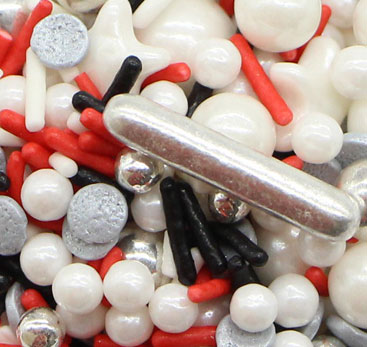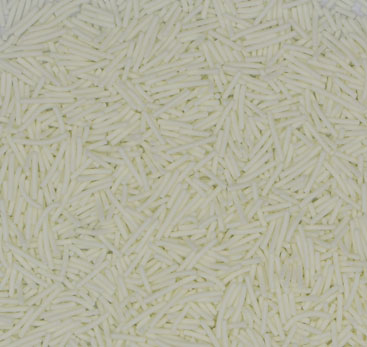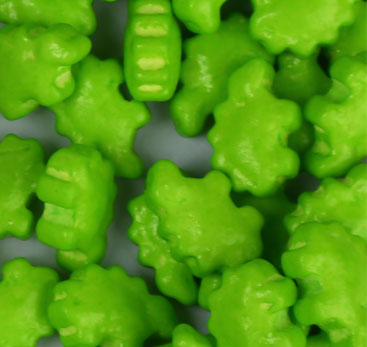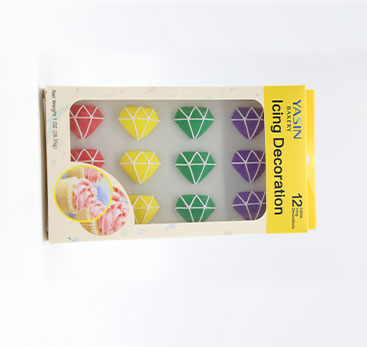The tiny, dazzling decorations called sprinkles transform everyday sweets into striking masterpieces. Sprinkles give a cheerful, festive touch, whether covering an ice cream, cupcake, or cookie. But have you ever considered what are sprinkles made out of?
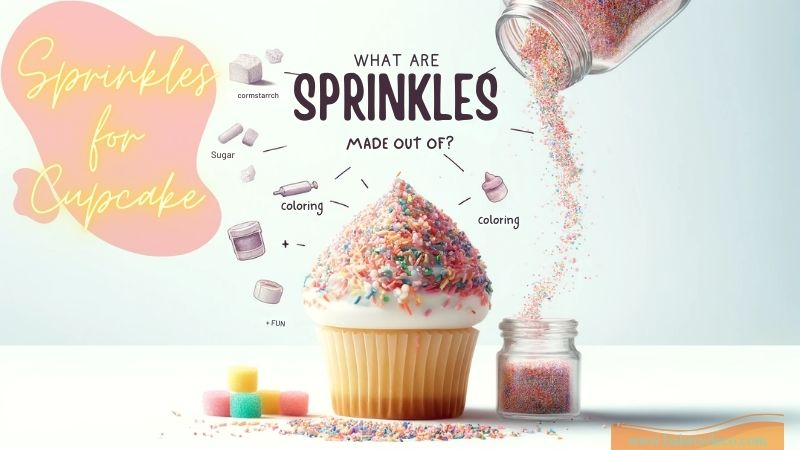
This post contains the components of sprinkles, the various varieties, the most popular sprinkles for cupcakes, cookies, chocolate, donuts, ice cream, and cakes, their nutritional content, and if they give any health benefits—or just more sugar.
What Are Sprinkles Made Of? The Basic Ingredients
Usually manufactured from just a few basic components, most classic sprinkles—also known as jimmies, nonpareils, or hundreds & thousands—are
• Sugar: The primary component of sprinkles' sweetness.
•corn syrup: Helps bind the ingredients and produce the proper texture by either cornstarch or corn syrup.
• Wax—Carnauba or bees walk—adds a small gloss and stops clumping.
• Food coloring offers vivid hues ranging from red to blue to green and yellow.
• Flavors (Optional) -Some sprinkles have vanilla or other extracts for added taste.
• Vegetable Oil: sheens and prevents clumping.
• Artificial flavors produce vivid colors and occasionally sprinkles for chocolate or vanilla taste.
• Small Amounts of Micronutrients: Fortification includes trace minerals, including iron, magnesium, and copper.
New-Age Ingredients in Modern Sprinkles
Though food coloring and sugar still rule, creative and health-conscious sprinkle manufacturers are changing things:
· Natural Colors: Sprinkles without artificial colors are now colored from beetroot, spirulina, turmeric, and butterfly pea flowers.
· Alternative Sweeteners: Sprinkles for keto-friendly and diabetic-safe employ alternate sweeteners such as monk fruit, erythritol, or coconut sugar.
· Gelatin-Free Glaze: Plant-based shine enhancers like rice bran or candelilla wax replace shellac or bees walk in the gelatin-free glaze.
How Are Sprinkles Made?
1. Creates a paste-like mixture of sugar, corn syrup, and starch.
2. Machines run the mixture through to produce long, noodle-like strands.
3. Along a conveyor belt, these threads break into little bits.
4. Finally, they get a crunchy texture and glossy look from food coloring and sugar glaze.
Are sprinkles vegan or gluten-free?
Vegan Sprinkles
Since most basic sprinkles are vegan and free of animal ingredients, though some companies utilize confectioner's glaze (shellac) from insects, most are vegan. Some variations could include gelatin, rendering them non-vegan.
Gluten-Free Sprinkles
Although some manufacturers process gluten-free sprinkles in facilities using gluten-containing components, the possibility of cross-contamination exists even if the sprinkles themselves do not contain gluten.
If you want certified gluten-free sprinkles, always read the labels.
Sprinkles Nutrition Facts: High in Sugar, Low in Nutrients
Though they are usually consumed in tiny quantities, sprinkles have high sugar, carbohydrate, and calorie count. Copper, magnesium, and iron are among the minor micronutrients they contain.
Chocolate-Flavored Sprinkles: Nutrition per two tablespoons (21g).
Nutrient | Content (Per Two Tbsp.) Cal | % Daily Value (DV) for Nutrients |
calories | 107g | - |
Iron | - | 2% |
protein | 0.5g | 1% |
Sugar | 13g | - |
Fat | 6.5g | - |
Fiber | 1g | 4% |
Copper | - | 10% |
Although they include minute levels of micronutrients (such as copper or iron), sprinkles are not a major source of vitamins or minerals.
Key Takeaways:
High in Sugar: Two tablespoons have roughly three teaspoons of 13g of sugar.
Low in Nutrients: Sprinkles are not a major source of vitamins or minerals, even if they offer minute levels of copper, magnesium, and iron.
High in calories: Their 107 calories per serving provide more energy than much nutritional value.
Should You Limit Your Sprinkle Intake?
The U.S. Department of Agriculture (USDA) advises reducing added sugar intake to less than 10% of daily calories. Under a 2,000-calorie diet, this comes to about 12 teaspoons (50 grams) daily.
Given that just two tablespoons of sprinkles have 13g of sugar, regular consumption could lead to too much sugar intake, which is associated with obesity and weight increase, Type 2 diabetes, heart disease, and liver diseases.
Healthier Alternatives to Traditional Sprinkles
Try if you enjoy decorating desserts but wish to reduce sugar intake:
• Fruit and vegetable-derived natural-colored sprinkles
• For crunch and nutritious fats, crushed nuts or seeds
• Lower sugar, more antioxidant dark chocolate shavings
• Dried fruit bits (adds inherent sweetener).
Types of Sprinkles & Their Best Uses
Not all sprinkles are identical! The most often used varieties are broken out below, with the best desserts to pair them with:
1. Sprinkles for cupcake
Ø Classic Jimmies: Perfect long, thin strands for rolling cupcake edges.
Ø The tiny, flat discs called confetti sprinkles have whimsical appeal.
Ø Pearlized sprinkles are shimmery and sophisticated for themed cupcakes.
2. Sprinkles for cookie
The small spheres called nonpareils stick tightly to the frosting. Quins, shaped sprinkles—heart, star, or seasonal designs for adorned cookies. Larger, crystal-like sprinkles for crunchy texture are sanding sugar.

3. Sprinkles for chocolate
Chocolate Vermicelli: Thin, delicate threads melted into chocolate.
Metallic Sprinkles: For a glitzy finish on bark or in gold or silver.
4. Sprinkles for Donuts
Rainbow Jimmies: The traditional selection for glazed donuts.
Crunchy sugar sprinkles give cake donuts texture.
For churros or spiced donuts, a cinnamon sugar mix is ideal.
5. Sprinkles for ice cream
Perfect for soft-serve, colorful nonpareils are small and lightweight.
Sprinkles for chocolate—essential for chocolate cones.
Mix-ins for sweetener ice cream. Usually prepared from sugar, cornstarch, and food coloring, colorful sprinkles for ice cream give your favorite frozen dessert a sweet crunch and vivid accent.
6: Sprinkles for cake
These are edible glitter for a brilliant cake topper.
Big confetti—perfect for birthday cakes.
Custom Letter Sprinkles — spell names or messages.
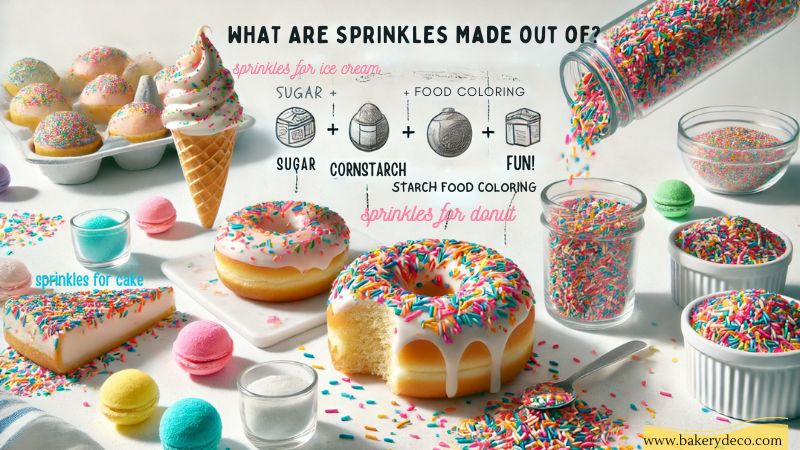
Move over cupcakes: sprinkle leftovers from the bakery into uncharted ground:
Top dessert sushi rolls with rainbow rice pearls.
Sprinkle Butter Boards: Whipped butter spreads have edible glitter and sugar pearls swirling throughout them.
Baristas top whipped cream or foamed milk with fine, edible glitter and sugar stars. They sprinkle charcuterie boards with sweet, crunchy tiny biscuits, sprinkles for chocolate barks, and frosted pretzels.
Specialty Sprinkles You’ve Probably Never Heard Of
Discover the sprinkled cosmos outside Jimmies and Nonpareils:
Luster Dust Sprinkles: Think of galaxy cakes; this metallic, high-gloss shine comes from sprinkles mixed with edible mica glitter powder.
Pop-Rock Sprinkles: These are ideal for children's sweets or party cakes for a sound and fizz blast.
Freeze-dried fruit crumbs: These are used for color and taste (like blueberry or raspberry crumbs)—like sprinkles on upscale pastries.
Savory Sprinkles: Indeed, there is such a thing. For gourmet donuts and inventive bakes, dehydrated cheese flakes, seaweed confetti, or sesame crunch.
ü Move over cupcakes: sprinkles for cupcake have left the bakery, and fresh ground has been found.
ü Top dessert sushi rolls with rainbow rice pearls.
ü Sprinkle Butter Boards: Whipped butter spreads have edible glitter and sugar pearls swirling throughout them.
ü Top whipped cream or foamed milk with fine, edible glitter and sugar stars from Latte Toppers.
Sweet snacking boards, chocolate barks, and frosted pretzels abound on sprinkles for cookie in Charcuterie Boards.
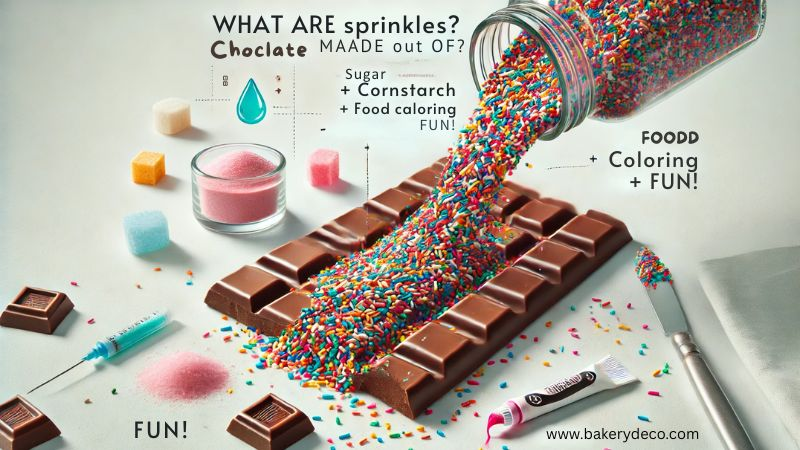
The Art and Science Behind Sprinkles: From Dough to Delight
Ø Though at first glance sprinkles appear like basic, colorful toppings, their path from raw ingredients to the adorable, glittering ornaments we adore is anything but normal. Although its makeup—powdered sugar, binding agents, and food coloring—is simple, the manufacturing process is a fascinating mix of accuracy and inventiveness. The magic starts when these simple components become a thick, flexible paste.
Ø An extruding machine molds this mixture into delicate, elongated threads—almost "sprinkle dough" in its rawest form. These threads pass on a conveyor belt into a tumbler, where they are softly broken down into bite-sized bits we know. Still, the metamorphosis is not finished. Though vegans should be aware—some glazes contain animal-derived components—the sprinkles are covered in extra food coloring and a glossy sugar glaze to attain their trademark vibrancy and brilliance. This last touch gives their visual appeal even greater and a pleasing, subdued crunch.
Once polished, the sprinkles are packed and delivered to retailers, ready to sprinkles for cake, cookies, and all kinds of delicious delicacies. And for those who would rather learn by doing? Making homemade sprinkles for cookie is feasible and delightful (and personalized).
How to make sprinkles at home
Do you want homemade, natural sprinkles without synthetic colors? Try this straightforward dish:
Ingredients:
§ One cup of powdered sugar
§ One teaspoon vanilla extract
§ Two to three tablespoons water or milk—dairy or plant-based
§ Natural food coloring—beet juice, turmeric, spirulina, etc.
Methods:
1.Create a thick paste with sugar, liquid, and vanilla.
2. Sort into small bowls, then sprinkle with natural food coloring.
3. Put all the colors in a piping bag with a tip.
4. Lay thin, long pipe threads onto parchment paper and let them dry overnight.
5. cut into small pieces once set, and your homemade sprinkles are ready!
(Tip: Add cocoa powder for sprinkles for chocolate.)
Where Should One Purchase the Highest Quality Baking Sprinkles?
Search for premium sprinkles here. Here are a few best suggestions:
• Wilton is suitable for seasonal and themed sprinkles.
• Sweet apolita: Superior, vivid colors for baking professionals.
• Fancy sprinkles are trendy combinations that make Instagram desserts.
• Custom mixes for special events from The Sprinkle Company
The edible tech future of sprinkles
• Smart Sprinkles: Experimental dessert labs add pH-reactive color-changing sprinkles on citrus or dairy-based desserts.
• Probiotic Sprinkles: Comprising micro-encapsulated probiotics, they improve intestinal health.
Conclusion:
It's time to get creative. Now you know what are sprinkles made out of and the ideal kinds for every dessert! The correct sprinkles will make all the difference whether you decorate a birthday cake, cupcakes, or cookies.
Want to stock up on the best sprinkles? Check out our top-rated sprinkle collections and elevate your baking game today!

